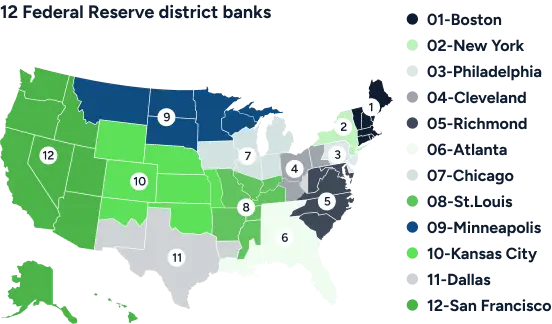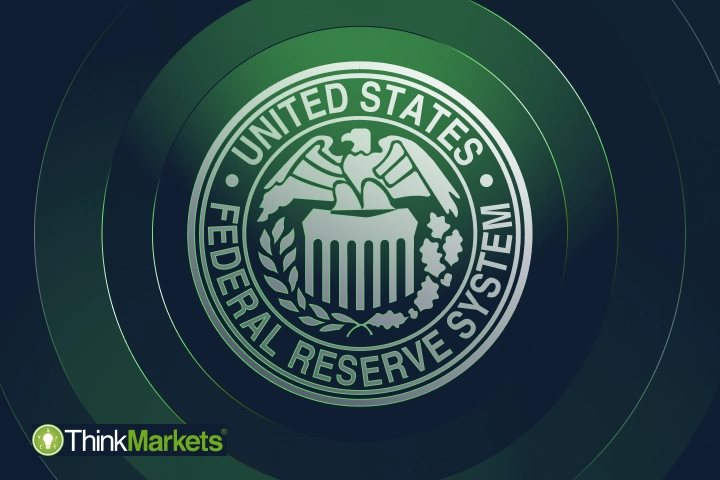Table of contents
- Federal Reserve: structure
- Purpose of the Federal Reserve
- Setting monetary policy
- The Federal Reserve’s impact on the markets
- How the Federal Reserve System affects traders
- Sign up with ThinkMarkets
The Federal Reserve System, or the Fed, is the United States of America’s central bank.
Following multiple financial panics, most notably the Knickerbocker crisis of 1907, the Fed was created when US President Woodrow Wilson signed the Federal Reserve Act on 23 December 1913. This was to ensure the country’s financial stability and avoid major economic disruptions.
Since then, the Fed has steered the US economy out of tough times, including the Great Depression of 1929-1933, post-war recessions, the Great Recession of 2008, and the COVID-19 recession.

Federal Reserve: structure
The Federal Reserve System is made up of four bodies:
- Federal Reserve Board (FRB)
- Twelve Federal Reserve District Banks
- Federal Open Market Committee (FOMC)
- Member banks
Federal Reserve Board (FRB)
The Federal Reserve Board (FRB) consists of seven members or governors. Their primary duties include overseeing the twelve District Reserve Banks, setting the national monetary policy, and regulating the US banking system. The President of the United States (POTUS) appoints governors for staggered 14-year terms, and a new term starts every two years.
Federal Reserve Banks
The twelve regional Federal Reserve Banks are responsible for regulating banks located in its district.

Federal Open Market Committee (FOMC)
The Federal Open Market Committee (FOMC) comprises of twelve members: the seven governors of the Federal Reserve Board (FRB) and five presidents of the Federal Reserve District Banks. The list of presidents to join the committee rotates at two- and three-year intervals except for the president of the Federal Reserve Bank of New York, which is a permanent member.
Member banks
Member banks are private institutions that own stock in their regional Federal Reserve bank. All nationally chartered banks in the US are members, such as the Bank of America, Wells Fargo, and Citibank. State-chartered banks may opt to be a member after they follow the conditions set upon by the committee.
Purpose of the Federal Reserve
The Federal Reserve System operates as an independent government body, meaning its decisions don’t need to be ratified to be implemented. According to the US Code section 225a, the Federal Reserve has three primary goals:
- Maximum employment
- Stable prices
- Moderated long-term interest rates
Setting monetary policy
The Federal Reserve System fulfills its duties by setting and, if necessary, adjusting the US monetary policy. The Federal Open Market Committee (FOMC) meets eight times yearly to decide whether the current monetary policy should be revised.
It uses three main tools to control the national monetary policy.
Open Market Operations (OMO)
OMO is the buying and selling of government securities, such as US treasury bonds, allowing the Fed to regulate the nation’s money supply. The Fed would buy securities to add money in circulation, lower interest rates, and increase economic activity when the US economy is in crisis. On the other hand, the Fed would sell off securities to reduce the money in circulation, raise interest rates, and decrease economic activity.
While decreasing economic activity sounds terrible, this is necessary for the Fed to control inflation rates. Inflation happens when prices significantly increase, affecting a consumer’s purchasing power. The Fed aims to keep the US economy at a steady 2% inflation rate.
Bank reserve requirement
The Federal Reserve System requires all depository institutions, banking institutions, credit unions, etc., to have a cash reserve proportional to client deposits. They must keep a certain percentage in reserve, the amount of which is set by the Fed’s Board of Governors, to ensure that clients will be able to withdraw their funds seamlessly.
For example, if a bank receives a total of USD 1 billion in client deposits and the current requirement is 10%, it must have at least USD 100 million in cash reserves in its vaults or at a regional Federal Reserve bank.
If a bank falls under the required amount reserve, it borrows from other banks at interest. This interest is called the federal funds rate and is the basis for most interest rates in the country. The Fed uses this to influence interest rates.
By decreasing the reserve requirement, the Fed allows banks to loan more money to consumers and businesses, thereby reducing interest rates and bolstering economic growth. Conversely, increasing the reserve requirement does the opposite. Banks hold their cash reserves tighter, making it harder for businesses to get a bank loan. This increases interest rates and dampens economic growth.
An excellent example of the Fed influencing interest rates was during the COVID-19 pandemic. Last March 2020, the Board announced that the reserve requirements would be at 0%. This allowed individuals and businesses to take out bank loans at low-interest rates to tide them over and expand during the pandemic, helping the US economy recover.
Discount rate
The discount rate is the last of the three monetary policy tools.
Similar to all central banks, the Federal Reserve also acts as a lender-of-last-resort. This means that when banks are experiencing a cash shortfall and there are no other willing lenders, banks can turn to Federal Reserve banks for support.
The Fed loaning funds to banks is the last option before bank failure. They require a much higher interest rate to discourage banks from borrowing from the Fed directly. The Fed also requires banks to put up collateral against the loan as a security.
When the Fed increases its discount rate, banks are less likely to undertake risky ventures in fear of high-interest rates. As such, the supply of money in circulation dries up as banks keep their cash in reserve. However, the Fed doing the opposite, pumps money into the economy. Low discount rates give banks the confidence to lend to more individuals and businesses.
The Federal Reserve’s impact on the markets
The Federal Reserve's actions, or lack thereof, significantly impact the markets. As such, traders closely monitor the Fed’s meetings. Even comments from the Board of Governors to the media can create some market volatility.
The trading community labels the Fed as either hawkish or dovish after a policy is announced. A hawkish Fed, named after the predatory bird, means that the institution is tightening up. For example, the Fed was hawkish for the entirety of 2022. To curb inflation, the Fed announced seven rate hikes, increasing the primary credit rate from almost 0% to 4.5% by the end of the year.
A dovish Fed, named after the mild bird, means that the Fed will be easing up on policies, lowering rates and allowing the economy to grow. High economic growth increases the employment rate, one of the Fed's primary duties.
The Federal Reserve adjusting the monetary policy has a massive impact on multiple markets, specifically forex, indices, and stocks. That’s why you will see a lot of movement before and after a Fed meeting, and specific reports are published.
The Fed goes through many economic indicators before implementing an action. However, trader speculation on Fed movement starts with either of two reports – the Consumer Price Index (CPI) and the Non-farm Payrolls (NFP).
Consumer Price Index (CPI)
The US Bureau of Labor Statistics publishes the CPI data every second week of each month. The CPI measures the average change in prices of basic consumer goods and services over a certain period of time. The CPI can quickly give an average of how much the cost of living has changed over time. It is also used as a way to measure inflation.
If the CPI reading rises, it means that the cost of living for an average consumer increased. On the other hand, if CPI reading declines, then the cost of living has decreased. Take note that the CPI is a weighted average of basic consumer goods and does not represent any individual situation.
Non-farm Payroll (NFP)
The NFP is a monthly report by the US Bureau of Labor Statistics on the net change in US employment, excluding farm workers, non-profit organisations, and private household employees. This report is a significant market mover for forex traders. Positive NFP news means the US economy is doing well, bolstering the US dollar against the other currencies.
A drop in employment usually implies an economic crisis, and the Fed tends to ease up on interest rates to let businesses take out loans and expand.
How the Federal Reserve System affects traders
The Fed tends to have a ripple effect on the markets, specifically forex, stocks, indices, and gold. Let’s take a look at each of the markets and how they are affected by Fed policies.
Forex
When the Federal Reserve raises interest rates, it makes the US dollar more attractive to both local and foreign investors. Bonds and savings accounts yield more interest compared to other assets. The increased demand for the US dollar makes the currency appreciate, and its value rises against other currencies.

For example, EUR/USD usually drops in price as the US dollar gains more value against the Euro.

USD/JPY, on the other hand, will rise in price as the US dollar can buy more units of the Japanese yen.
Conversely, lowering interest rates can depreciate the US dollar as foreign investors turn to other currencies with more attractive interest rates.
Stocks and indices

As indices track company stocks, we will group them into one.
The Federal Reserve raising interest rates can create a downward trend for US stocks and indices. The FOMC taking a hawkish stance often ends up with stocks and indices losing significant value.
Businesses lose access to bank loans which they can use for expansion strategies, while consumers lose access to low-interest rates and thus spend less. Decreased consumption would mean stocks take a hit on their earnings reports which can alarm investors.
Like the forex market, a decrease in the value of US stocks and indices can benefit foreign stocks and indices.
Gold

There is an inverse relationship between gold prices and the Fed’s interest rates. Gold loses appeal as a safe-haven, non-interest-yielding asset whenever the Fed increases rates. This pushes gold prices down as investors flock to riskier, more interest-yielding assets such as shares and bonds.
On the contrary, the Fed lowering rates may make investors worry of an impending economic crisis. They would then turn to gold to protect the value of their wealth, creating a price hike in the spot price of this yellow metal.
Sign up with ThinkMarkets
The Federal Reserve plays a massive role in the global economy. Traders often get anxious whenever they see the Fed making headlines. However, there’s no reason to worry too much if you trade with ThinkMarkets. Here are three reasons why:
A wide range of choices
With a ThinkMarkets Standard account, you can access 4,000+ instruments across multiple markets, including forex, stocks, indices, commodities, cryptocurrencies, ETFs, and futures. This means that you can find instruments that are less likely to be affected by the Fed’s actions.
Go long or short
A rise in interest rates may put downward pressure on US stocks and indices, but as a CFD trader, you can potentially benefit from this outcome by going long or short on instruments. This means that you can take advantage of both falling and rising markets.
Regular market updates and Economic calendar
We have partnered with multiple third parties to provide our clients regular market updates and a global economic calendar. This lets our traders stay up to date with the latest financial news and plan their trades accordingly.
Trade the Fed report today!





